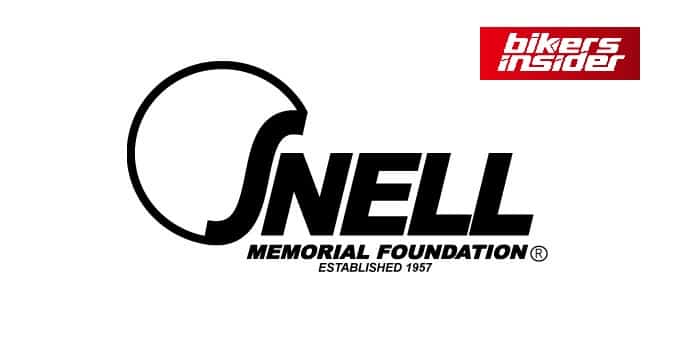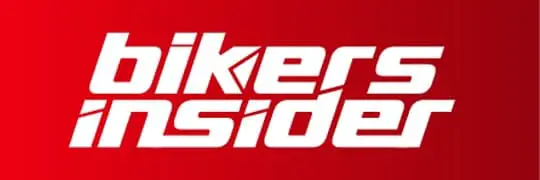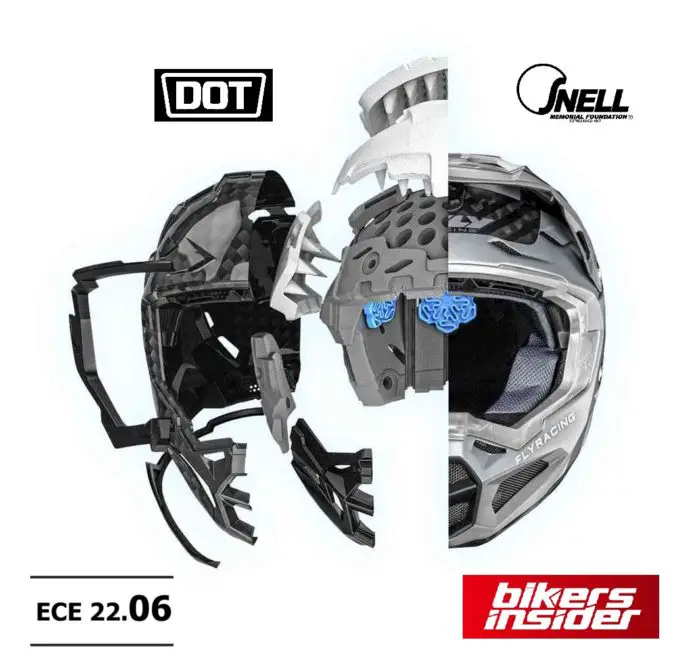Table of Contents
Introduction
There are many different styles of motorcycle helmets, and not all of them are made in the same manner or meet the same motorcycle helmet standards. A helmet, which appears to be the most basic motorbike gear, is vital to a rider’s safety. Wearing a helmet in a motorcycle crash decreases the risk of brain injuries by about 70%. According to the NHTSA, it reduces the risk of death by 30%. It’s now more crucial than ever to know how protective your headwear is.
DOT, SNELL, ECE, and SHARP stickers are undoubtedly on your helmet. But did you know these stickers represent the quality of your motorbike helmet? Before receiving a safety rating, each helmet is subjected to many safety factors, including impact testing. A motorcycle helmet rating certification specifies the extent of protection a helmet provides.

How many helmet standards are there in the market?
You’ve seen a variety of stickers on the rear of your helmet if you’ve spent any time looking at it. One or more of these stickers may be seen on your lid and or show various certifications:
The U.S. Department of Transportation sets the DOT standards.
The federal standard FMVSS 218 is the current DOT rating. Any helmet with the DOT sticker must follow this standard (more on that later).
Economic Commission for Europe (ECE) motorcycle helmet standards
More than 50 European nations adhere to this international standard. Thus, any helmet bearing this label must meet the most recent ECE 22.05 and from July 2022 ECE 22.06.
The Snell Memorial Foundation
The Snell Memorial Foundation sets the SNELL motorcycle helmet standards. Only a few racing organizations demand this type of testing, and it is always done. SNELL M2020 is the current standard for street usage.
Motorcycle helmets that fulfil the safety of motorcycle helmet standards set out by the world’s largest motorcycle racing organization are given the FIM rating, which is a new grading system.
Certification stickers on helmets
Please make sure the sticker on your helmet shows that it’s a helmet and not a salad bowl before you get on the bike. The term “novelty” helmet refers to genuine helmets that don’t have a DOT or ECE label. These are dangerous, offer no protection, and are thus unlawful to wear when riding in regions or conditions where a helmet is required by law.
So, you may have an ECE-certified helmet, or even one that meets all three criteria, depending on your picks.
The motorcycle helmet industry has recently seen the entry of a fourth testing agency. Instead of certifying helmets, the SHARP method offers a “star rating” to European-made helmets.
Helmets are essential gear for motorcycling.
Every year, motorcycle helmets help save the lives of countless individuals. Many motorcyclists would still be alive today if they had been wearing a helmet.
Choosing a full-face helmet instead of an open-face (jet) helmet is preferable because full-face helmets are better. Crash victims frequently hit their chins and faces when riding motorcycles. There is a 45 per cent chance that an impact to a motorcyclist’s head will occur on the part of the head that only a full-face helmet covers.
Know your helmet
With some knowledge of helmet design and construction, you can make a better purchasing decision. This is because some helmets are better than others.
No one standard is better than the others; rather, our goal is to explain how motorcycle helmet standards compare and where they are applicable. These motorcycle helmet standards are not mutually exclusive; some helmets have numerous certifications.
The following is a breakdown of each standard’s requirements.
DOT motorcycle helmet standards
The Department of Transportation (DOT) of the United States evaluates whether a helmet is safe to use. It is one of the most fundamental helmet requirements. The Department of Transportation (DOT) is a government agency. So, helmet manufacturers put their products through rigorous testing and refinement. They ensure that they exceed DOT safety bars.
Helmets that have been certified by the DOT must meet various criteria. It includes a wide FOV, resistance to penetration, impact negation, and more. Federal Standard FMVSS 218 appears on the helmet as a tag provided by the Department of Transportation (DOT).

Testing method
Helmets that are DOT approved have undergone two rounds of testing to withstand the impact of a collision. A penetration test with sharp items is also performed to check the helmet’s shell. The test helmet is dropped from a height of 1.83 meters to create a G-force of 400G during the fall on two different surfaces.
As a result, scientific instruments are used to assess the effect. Loads of 22.7 kg are applied for 30 seconds, then raised to 136 kilograms for 120 seconds to test the strength of the helmet strap under stress.
Unfortunately, FMVSS 218 is one of the few standards that has not been tested by the issuing body. Independent contractors are hired to randomly test helmets to spot any defective ones.
PROS
- Scheme for high-energy testing with two blows per spot on a hemispherical anvil.
- Technicians can hit the helmet at any point within a vast region.
- 400 g of maximum permissible energy transfer is a good value.
CONS
- “Honor system” random testing is ineffectual, and many helmets marked DOT may not genuinely pass the standard.
- The usage of a small number of head forms
- Non-impact energy management testing is a little scarce: insufficient research on critical aspects like optics, removability, friction resistance, and many others.
ECE 22.05 motorcycle helmet standards
ECE 22.05 stands for “Economic Commission for Europe.” Guideline 22 provides the basic standards for motorcycle and scooter helmets. More than 50 European countries use them. ECE 22.05 is a somewhat new standard compared to DOT FMVSS 218. Yet, it ensures that helmets will be subjected to more thorough and rigorous testing. Most major motorsport organizations, including MotoGP, Formula One, the AMA, and CCS, have accepted ECE certification.
Every vehicle’s safety system component must pass rigorous ECE-approved testing to receive this certification. The lower average motorcycle accident speed in Europe has a considerable impact on the development of ECE impact testing. A smooth anvil is used in ECE tests to administer a lower-energy hit than the Hemi anvil (the Hemi anvil is used in DOT and SNELL). Besides, ECE clearance testing involves a single impact on fixed points rather than the usual multiple-hitting within set spots.

Testing
More ECE 22.05 certification testing includes abrasion resistance testing. A high load retention test of more than 300 kg and chin strap slippage. Instead of self-testing as DOT certification requires, the helmet must undergo ECE certification testing before being sold. Before an ECE helmet certification can be issued, independent agencies must first test it with representatives.ECE 22.05 helmets are tested in different countries.
The difference in US and European collision speeds
There are considerable differences in motorcycle collision speeds between the US and Europe. This is an essential factor in the design of ECE impact testing.
Here is a single blow in the ECE impact tests, which results in a low-energy testing system. Yet, ECE tests need technicians to strike helmets at predetermined locations. Unlike the other two standards, which enable technicians to crash helmets anywhere within a range. It allows helmet companies to “game the system” by improving protection to pass a dangerous helmet at certain spots.
PROS
- All ECE-certified helmets are rigorously tested to ensure compliance with the standards.
- Only a small amount of peak energy is permitted (only 275 g)
- Comprehensive testing for a wide range of safety-related functions.
- More variables may be tested with eight different head forms.
CONS
- Testing using a curbstone anvil and a single hit results in extremely little energy, which may be inappropriate for American speeds.
- The impact testing may be cheated if the striking helmet positions are predetermined.
- Testing with a variety of head forms can result in a shifted centre of gravity, resulting in a 20 per cent reduction in impact energy.
Snell (Snell Memorial Foundation M2010) motorcycle helmet standards:
The SNELL Memorial Foundation has long been the darling of the helmet industry. It is still regarded as the gold standard for helmet safety. An edge anvil profile is used in SNELL M2020 certification and requires 275 g most energy transfer after two impacts. The extra testing for attributes like stability and simplicity of removal in an emergency reflects the fact that SNELL testing is developed with the racetrack’s energy levels and safety needs in mind.
The helmet technician’s significant degree of control over the testing procedure. It sets SNELL apart from other helmet standards. Technicians at SNELL seek the helmet’s weakest spot. Such as a metal visor snap or mechanical hinge, focusing their testing on that area. Technicians will test the helmet’s energy-management capabilities in several places. They are convinced that they have obtained an accurate indicator. There will be a “helmet autopsy” when the EPS liner and other internal components are examined. It is for indications of weakening to ensure that the helmets are safe.

SNELL M2010
SNELL’s M2010 standard was criticized for pushing “overly hard” EPS liners. The liners were rigid enough to allow for increased force transfer at lower energy hits to achieve the SNELL criteria for higher energy impacts. In principle, this was a good plan. But in actuality, the argument didn’t stand up very well. The three anvil forms used by SNELL testing are flat, hemi, and edge. Aside from its severe (and high-energy) state, the flat anvil is identical to that employed by the ECE and DOT. Helmets that enable more than 275 g of energy transfer during a flat anvil hit are considered “too hard” to be safe in low-speed accidents.
PROS
- All SNELL-certified helmets go through a rigorous testing process.
- Only a small amount of peak energy is permitted (only 275 g)
- Stability, detachability, and face shield breaking testing
- Intense impact energy is tested on an “edge” anvil.
- Helmets are thoroughly inspected by technicians to provide the best possible testing.
CONS
- As private SNELL testing costs rise, so does the selling price of helmets that have been certified by the organization.
- Some SNELL helmets may not be suitable for street usage because of their racing focus (internal sun shield, most modular helmets)
UK SHARP Motorcycle Helmet Certification
The newcomer to the helmet safety game has taken things a step further by awarding a star grade. It is based on the helmet’s performance in variousxus impact locations and energy levels.
To put it simply, SHARP is an impact rating upgrade of the ECE 22.05 standard. It is why SHARP evaluates helmets that have before passed ECE certification. SHARP assigns a “safety rating” to each part of the helmet based on European crash data.

Helmet buying community’s reservations about SHARP
Much of the helmet-buying community has reservations about SHARP. SHARP‘s more rigorous testing techniques, the colour-coded “zone” breakdown of each tested helmet and the “star rating” system are all applauded by advocates of the safety program. They believe that SHARP’s “star ratings” oversimplify a complicated issue like helmet safety. The colour-coded ratings based on one impact site in a zone do not consider the array of variables in a motorbike incident and are thus inaccurate.
No matter how you feel about the SHARP safety program, keep in mind that it was created for the European market. Keep in mind that the helmet evaluated by Sharp may be substantially different from the one you’d buy if you’re looking for a DOT helmet.
PROS
- Unlike any other testing method, helmets are subjected to high- and low-velocity impacts.
- Extensive impact testing was conducted.
- Helmets have five places of impact.
- helmet autopsy is performed after a collision to look out for any weak areas
- Many consumers prefer rating systems beyond the standard “pass/fail.”
CONS
- Critics argue about the usefulness of “star” and “color code” grading systems.
- Testing based on European crash data ignores the varying energies and riding circumstances seen in the United States.
- Curbstone and flat anvils are used instead of DOT or SNELL-regulated hemi anvils to simulate lower energy levels.
ECE 22.06 will replace ECE 22.05 in the near future
As of June 2020, ECE 22.05 will be replaced by ECE 22.06, and the.05 or.06 refers to specific changes and updates to the No. 22 regulatory framework. Twenty years ago, in June 2000, ECE 22.05 was put into place.
In the last 20 years, motorcycle helmet manufacturers have seen tremendous technical, design, and engineering developments.
Implementation of ECE 22.06
As a result, new adjustments must be made to accommodate the slew of new features and materials found in helmets. Companies have until January 2024 to build helmets that match the new criteria, which provides them plenty of time.

When ECE 22.05 comes into effect, helmets that satisfy that standard will still be legal to sell as new. New helmets supplied by a manufacturer to a distributor or store must be ECE 22.06 certified after January 1, 2024. However, you can continue to wear your current ECE 22.05 helmets. Currently, stores may continue to sell ECE 22.05 helmets after this date, although this may alter in the near future.
Conclusion
There are many aspects to consider when purchasing a helmet, and selecting the proper safety certification is only one. Several factors contribute to the overall safety of a rider, such as a helmet’s fit, quality, comfort, simplicity of use, and feature set. Fog-free glasses and lighter, quieter helmets are two ways to make riding more comfortable and less exhausting for the rider. These safety elements may help prevent accidents from occurring in the first place.
The importance of proper fit cannot be overstated! In fact, all four testing organizations emphasize the need to use head forms that fit correctly throughout testing. The effectiveness of your helmet in absorbing impact energy will be hampered if it does not work properly. You are safe with a $100 DOT helmet that’s the proper fit than a $900 SNELL helmet that’s too big.



What makes the price of a helmet, be so high?
Other than material and the design of a helmet.
What makes it so expensive?I m somewhat new with your line of helmets.Can u help me pick a 50/50% model?
Seriously interested in purchasing a new motorcycle, and $300.00
On a abus lock&chain,
Need a decent price for a
Helmet, retired Vet. What
Can u recommend on a Helmet?bwt.$100-$300.00